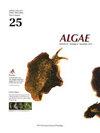Endoplura jejuensis sp. nov. and Endoplura koreana sp. nov. (Ralfsiales, Phaeophyceae) from Korea based on molecular and morphological analyses
IF 2.4
3区 生物学
Q1 MARINE & FRESHWATER BIOLOGY
引用次数: 3
Abstract
The crustose brown algal genus Endoplura has been known as a monotypic genus characterized by its intercalary plurangial reproductive structures composed of 2–4 separate parallel filaments terminated by 2–5 sterile cells and by containing several to many chloroplasts per cell. In this study, Endoplura jejuensis sp. nov. and E. koreana sp. nov. from Korea are newly described based on molecular and morphological analyses. Our phylogenetic analyses of the rbcL gene reveal that E. jejuensis sp. nov. and E. koreana sp. nov. are placed in the same clade with “E. aurea” from Japan with a strong bootstrap supporting value. E. jejuensis is characterized by small and light to dark brown crustose thalli of less than 1 cm diameter, tufts of hairs arising from the basal disc, plurangia composed mostly of two separate parallel reproductive filaments terminated by 2–4 sterile cells, and sessile unangia each with a single paraphysis. E. koreana is distinguished by olive or yellowish-brown crustose thalli of up to 3 cm diameter, tufts of hairs arising from the basal disc, and apical parts of erect filaments, plurangia with 2–5 separate reproductive filaments terminated by 2–8 sterile cells, and sessile unangia with 1–2 paraphyses. Our studies also show that “E. aurea” specimens from Japan may be recognized to be a different species from other Endoplura species.基于分子和形态分析的韩国jejuensis sp. 11和Endoplura koreana sp. 11 (Ralfsiales, Phaeophyceae)
壳褐藻属Endoplura是一种单型属,其特征是由2-4个独立的平行细丝组成,由2-5个不育细胞终止,每个细胞含有数个至多个叶绿体。本文根据分子和形态分析,对韩国的jejuensis sp. 11和E. koreana sp. 11进行了新描述。我们对rbcL基因的系统发育分析表明,空肠E. jejuensis sp. 11和韩国E. korea sp. 11与E. jejuensis sp. 11处于同一进化支。来自日本的aurea,具有很强的引导支撑价值。jejuensis的特点是:直径小于1厘米的小而浅至深棕色的壳状菌体,从基盘长出的毛簇,多子体主要由2-4个不育细胞终止的两个独立的平行生殖丝组成,无梗的单根胞具一个侧突。其特征是直径可达3cm的橄榄色或黄褐色具硬壳的菌体,基部花盘生毛簇,直立花丝的顶端部分,由2-8个不育细胞终止的2-5个独立的生殖花丝的多子体,以及具有1-2个突状突起的无梗无子体。我们的研究还表明,“E。来自日本的金莲属标本可能被认为是与其他内层属不同的种。
本文章由计算机程序翻译,如有差异,请以英文原文为准。
求助全文
约1分钟内获得全文
求助全文
来源期刊

Algae
PLANT SCIENCES-
CiteScore
5.10
自引率
25.00%
发文量
18
期刊介绍:
ALGAE is published by the Korean Society of Phycology and provides prompt publication of original works on phycology. ALGAE publishes articles on all aspects of phylogenetics and taxonomy, ecology and population biology, physiology and biochemistry, cell and molecular biology, and biotechnology and applied phycology. Checklists or equivalent manu-scripts may be considered for publication only if they contribute original information on taxonomy (e.g., new combinations), ecology or biogeography of more than just local relevance. Contributions may take the form of Original Research Articles, Research Notes, Review Articles and Book Reviews.
 求助内容:
求助内容: 应助结果提醒方式:
应助结果提醒方式:


